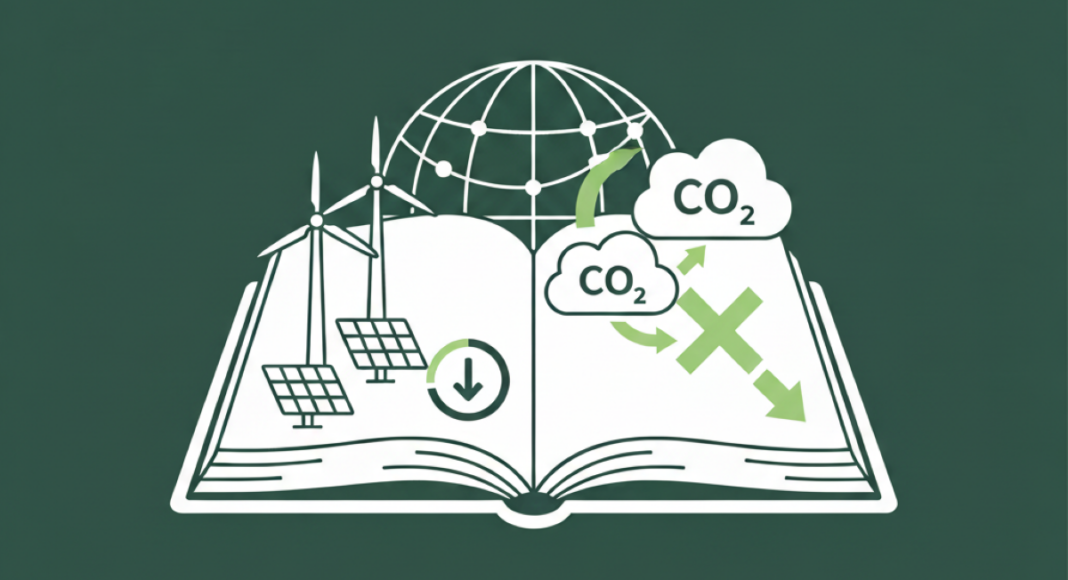Corporate decarbonization policy has stagnated under ideological divisions. Arguing that anthropogenic emissions are driven by customer preferences and that such preferences can shift with improved information, Karthik Ramanna advocates for a new approach: an economy-wide system of reliable and comparable accounts of the embedded emissions in products to allow customers (and investors) to make better-informed decisions aligned with underlying preferences. In the first of two articles, Ramanna discusses why top-down regulatory approaches to reduce greenhouse gas emissions have failed to generate decarbonization at meaningful scales and the virtues of a pro-market approach to incentivizing and enabling greener corporate and consumer behavior.
About one in every three molecules of carbon dioxide in the atmosphere was only put there since the Industrial Revolution began in the middle of the eighteenth century. And about half of that amount (or one-sixth of the total) has been spewed out only since China and India embraced economic liberalization over the last four decades. In many parts of the world, and overwhelmingly amongst scientists, anthropogenic greenhouse-gas (GHG) emissions are recognized as a defining challenge to the world as we know it.
Writing this in 2025, the already fragile political consensus on how humanity can best deal with the challenge appears to be rapidly falling apart, including in the United States and European Union. That consensus is the product of a political process involving diverse interests, including some climate-science advocates, left-wing activists who distrust capitalism, businesses and financial institutions who see economic opportunity in environmentally sustainable products, and members of the voting public at large. This group is motivated by growing evidence that human activity is causing dangerous climatic changes.
The consensus that emerged over the past decade or so broadly entailed pursuing public policies that drive firms (and consumers) to choose certain technologies over others, such as electric vehicles (EVs) over those running on fossil fuels, and to engage in practices such as recycling that mitigate the further release of geologically stored carbon into the atmosphere. To this end, there has also been pressure on companies to become “net zero” GHG emitters by a certain date (or at least self-declare such an aspiration), the sooner the better. The approach here implicitly legitimizes some top-down control over current consumption decisions for the sake of future generations. The approach has worked in some cases. For instance, fuel-economy and appliance-efficiency standards appear to have contributed to lowering GHG emissions. But the impact of these policies is still small relative to the task at hand, as evidenced by the generally increasing annual global carbon dioxide emissions. And importantly, some elements of the approach, such as consumption tax hikes on fuel, have proved polarizing, coalescing opposition from even those who might be persuaded by evidence on the seriousness of climate change.
The intellectual arguments underpinning growing opposition to top-down environmentalism can be traced to the commonly held axiom that human flourishing is best delivered by allowing free choice to operate without many regulatory constraints. This argument appeals to business elites who both profit from and feed individual desires for material well-being—desires for cars, gadgets, and other use-and-throw luxuries that are seen as essentials in a prosperous modern society.
Crucially, this argument also appeals to many voters who fear that a green transformation will deprive them of opportunity and wellbeing: Dutch farmers facing the costs of EU environmental diktats, coal miners in West Virginia, factory workers in Vietnam, or the newly minted middle-class in India who seek cars, air-conditioned homes, and so on. These individuals are generally less well-off than the environmental advocates, and their shared fear of environmental burdens imposed from above explains, at least partly, why some decarbonization policies have come to be seen as elite, illiberal projects. The blowback to aggressive top-down environmentalism might even help us understand why some traditionally unionized blue-collar workers, especially in the West, are making common cause with right-wing parties that they previously shunned.
Here, I will argue that the seeds of a solution to what might seem like an irreconcilable political standoff are already with us. I will argue that what we need to do is subtly catalyze our market-capitalist system, through a robust, global emissions-accounting system (akin to financial accounting), so that it progressively delivers systemwide emissions reductions by mobilizing freely made decisions towards that goal. Of course, adapting a complex system such as market capitalism to driving voluntary reductions in GHG emissions requires just the right degree of public priming, so that it sets in motion a series of self-correcting innovations while resisting policymakers’ urges to prejudge their own favorite innovations. In what follows, I draw on my background as a scholar-practitioner of designing market-governance institutions, of coalition building, and of emissions accounting to unpack the case to get that priming going.
The bottom-up basis for addressing GHG emissions
My first premise is that anthropogenic GHG emissions result from billions of decisions made at every level of economic activity: from an individual’s decision to drive to work rather than take a bus, to a company’s decision to put out a product upgrade and render the old model obsolete, to a decision to turn up the heat on a cold winter’s night, or to choose a delicious steak on your birthday. Thus, although most anthropogenic emissions of GHGs into the atmosphere come from just a few sources like fossil fuels, industrial chemical reactions, and cattle rearing, the reasons for the demand for these “brown” commodities, goods, and services are numerous, complex, and dynamic. Reducing GHG emissions therefore involves making many different—and often interdependent—decisions, and what those decisions are isn’t always obvious, even to sophisticated players.
A recent article, for example, described how managers at Hitachi Energy discovered that using recycled copper in manufacturing electric transformers could, under certain circumstances, involve releasing more GHGs into the atmosphere than would be done by purchasing newly mined copper. Another striking example connects the steel and cement industries. Blast furnaces used in steelmaking are heavy emitters of CO2, so some governments in Europe have issued directives to replace them with alternative technologies. But blast furnaces also generate slag as a by-product, which can replace limestone-based fillers in the manufacture of cement. Without the blast furnaces, you have no slag, and you may have to go back to using the CO2-intensive limestone-based fillers, which can paradoxically mean more emissions than if the governments had simply let the blast furnaces stay. This is a good instance of how the interconnectedness of our global economy means that so-called “locally optimal” solutions to climate change can in fact derail real progress on the problem.
In essence, we don’t know which technologies or policies will be most effective in reducing total emissions, what unforeseen side-effects they may have, and where true solutions will come from. In the Hitachi Energy case, with a more thorough accounting of emissions, the current preferred solution seems to be to purchase copper from low-carbon mines in Sweden. But that situation could change if copper recyclers found new low-emissions ways to harvest used copper. Put differently, reducing global emissions is an ongoing process of decision-making that relies on billions of independent agents in the economic system making evolving choices, adapting, for instance, the technologies they deploy or the products they buy in ways that are not entirely knowable or controllable beforehand.
This vision of change conforms more to capitalist models of bottom-up innovation and commerce than with the idea of a top-down imposed set of low-emissions technologies. Deploying the principles of individual autonomy and self-interest has helped a diverse range of complex societies address all kinds of communal challenges, and it has led to the creation and rapid adoption of wave upon wave of new technologies, as entrepreneurs compete for customers. Of course, some of these technologies are wildly successful and others just fail. In the late-nineteenth and early-twentieth centuries, electric motors competed with combustion engines, and electric lights with gas. Today, EVs are competing with hydrogen vehicles, while satellite dishes compete with fiber-optic cable.
The bottom line is that the capitalist system is not monolithic and unchanging. It is instead dynamic and adaptive, reflecting the ever-evolving preferences of the billions of the system’s autonomous actors. Conditional on sound governance institutions, the system generally works to efficiently deliver on those actors’ preferences. But, as the actors’ understanding of value and their ability to gauge it change, so too will the methods deployed by the capitalist system. And, as in other dynamic, adaptive systems like biological evolution, the functioning of capitalism (strategies, methods, technologies, etc.) can change in unpredictable ways.
Several major policy attempts to address anthropogenic GHG emissions over the past decade have gone in the opposite direction to enabling such bottom-up innovation. Take EVs, for example. Many Western governments have made implicit bets that the path to emissions-free transportation must involve EVs, perhaps at the expense of alternatives such as hybrid vehicles and the permanent sequestration of atmospheric carbon dioxide to offset emissions from fossil-fuel cars.
But although EVs operate without emissions, charging them does involve emissions. China, one of the fastest-growing EV markets, generates much of its electrical energy from coal-fired power stations, which can be dirtier than some gasoline cars. What’s more, simply creating the added grid infrastructure for the functional charging network needed if we are to have a large-scale switch to EVs will emit millions of added tons of CO2 due to the new steel and cement requirements. And it remains unclear if EVs will last as long as gasoline cars and what will be the emissions from battery recycling. So, while a bold commitment to EVs may appear to be worthwhile in top-down policymaking, an actual accounting of the associated emissions from EVs versus alternatives is needed to avoid costly policy mistakes.
In fact, Toyota’s hybrid vehicle model may well turn out to be a far smarter bet, as it promises to reduce automobile emissions by 40% without increasing emissions from power generation. In the longer term, hydrogen-powered cars that don’t add strain to the grid could potentially represent an attractive alternative. My point is that skewing the playing field in favor of EVs—or, for that matter, any subset of technologies—through government-mandated regulation or subsidies could end up creating more problems for the environment than it solves. Given the systemic and interconnected nature of the problem’s origins, expecting government policymaking to identify successfully the right few silver-bullet solutions seems risky. What governments can do instead is introduce a basic coding into the system to reward continuous experimentation and innovation toward global emissions reductions.
A universal performance metric to coordinate market action
There are already encouraging signs that the market economy is making emissions efficiency a basis for competition. For instance, recent research has shown how major producers of even rank commodities like cement are engaged in rigorous emissions calculations across different operational processes and supply-chain options to credibly lower the embedded emissions in their products as a means to differentiate (and upcharge) the prices between cleaner and dirtier cement.
On the customer side, product-labeling intermediaries have proliferated to help buyers make sense of emissions claims. And the trillions of dollars in “sustainable finance” is testimony to investor interest in the area, even if there remains concern about how real this is. Such developments suggest that the capitalist system is, indeed, evolving, as a resilient, complex adaptive system should. But progress is still uncertain and, perhaps, not fast enough, which can explain the desire of some climate advocates to drive top-down solutions. And as recent scandals over faked carbon offsets indicate, investment in green technologies is bedeviled by the lack of robust metrics, making it well-nigh impossible for markets to deliver on emissions reductions at the scale science suggests is necessary. We need to coordinate and catalyze the process.
With the vision for bottom-up innovation as laid out above, the essential task becomes creating information for consumers and incentives for firms to freely make choices that really do reduce their GHG emissions. This requires the ability for firms to calculate and report at least at the level of individual products (and services) the emissions embedded in those outputs. The granularity of accounts to the level of products is important because it is arm’s-length transactions of products that actually characterize the working of markets. Of course, to be useful for decision-making, the product-level accounts must be verifiably accurate, comparable across alternatives, and consistent over time, so that investors and customers of a firm or output can assess its environmental performance relative to that of peers.
The presence of such a robust, product-level, emissions-accounting system will enable businesspeople and consumers alike to incorporate environmental value into their everyday choices. Moreover, beyond channeling consumers’ existing and (slowly) evolving preferences for emissions-efficient products, robust information supply can create its own new demand. We saw this effect with the introduction of nutrition labeling on food items. For instance, where previously sugary tastes substantially drove purchases of breakfast cereals, better nutrition information shifted consumption preferences to include health factors. This unleashed a fresh wave of product innovations, disrupted old players, and created new value.
Another comparable development is just-in-time (JIT) inventory information systems. Prior to the development of JIT, companies in the business-to-business (B2B) space largely competed on two dimensions: cost and quality. Their customers, also businesses, had to hold large quantities of inventory, tying up large amounts of their capital, in order to meet their own production schedules. But with the advent of JIT information systems, the suppliers could now compete over three dimensions: cost, quality, and timeliness. The business customers, who might have previously held months or weeks of inventories, could now hold days or just hours of inventory. This freed up capital across the system to be deployed to other uses, seeding more innovation. (Toyota is a classic example of a company that benefited from and thrived on JIT.) Just as JIT unleashed new forms for how the capitalist system could function, so too can product-level emissions accounting by allowing companies to compete on four dimensions: cost, quality, timeliness, and emissions.
In some cases, under this approach, cost and emissions reduction will be aligned. That is, the low-emissions product will also be lower cost, creating win-win situations for customers and consumers (holding quality and timeliness constant). In other cases, customers and consumers will have to trade off lower emissions with higher prices. For example, an early pilot study of the approach conducted with a tire maker revealed that it would take a 30% increase in costs to achieve a 22% reduction in emissions per tire, given extant technology and prices. When the tiremaker shared this information with its customer, a carmaker, that customer was open to paying this premium for tires installed on its luxury models, as its own consumers would likely pay that premium themselves. But for its entry-level models, the carmaker was unwilling to accept the low-emissions tires as yet. It asked the tiremaker to find ways to ride down the cost curve of the emissions-saving technologies to offer products at prices that would more closely match consumers’ willingness to pay.
In still other cases, quality and emissions reduction will be aligned, but at the expense of cost. That is, a low-emissions product will be expected to offer better quality (e.g., last longer) for a higher price. Here, even entry-level customers may be willing to accept the price premium in return for the expectation that they keep, for instance, their cars or tires longer. More broadly, the emissions accounting approach can induce the internalization of anthropogenic GHGs into prices.
In such a system, companies could compete to offer lower-emissions products through the value chain, with ultimate decisions being driven by consumers based on clearly communicated cost, quality, and emissions value-propositions. For instance, in the B2B space, steel companies would compete on the embedded emissions of their steel (beyond factors like cost and quality), and further downstream, original equipment manufacturers using lower-emissions steel could have an added advantage when selling their products (e.g., home appliances) to end users. Investment capital would then more readily flow towards promising emissions-efficient technologies, potentially creating scale efficiencies.
Admittedly, this approach may not be as far-reaching on decarbonization goals as some climate experts suggest is necessary. Just as nutrition labelling did not eliminate junk foods but still made health foods more competitive, new rigorous information on emissions can shift demand and supply curves to support greater corporate decarbonization action. However, such action may only restrict us to, say, a global 2.5-degree temperature increase (over pre-industrialization levels), which would be above the UN-targeted 2-degree increase.
That said, the process that would generate this higher number is more plausibly achievable than a top-down regulatory approach, which, despite years in operation, appears to have made little progress in actually reducing GHG emissions into the atmosphere. Besides, the pro-market approach does not forestall the continued use of regulations where there is evidence that they work. In fact, a comprehensive emissions accounting system can provide such evidence in a clearer manner than is currently possible.
The pro-market approach is, of course, contingent on customers being sensitive to emissions information, and current evidence to this end is mixed. But inferences from such evidence today are hobbled by the absence of a comprehensive, comparable, reliable emissions accounting system, as I will discuss in part II. There, I will elaborate on the principles of an accounting methodology to provide better greenhouse gas emissions data to business customers and consumers and the reasons why, based on historical precedent, such a system is readily adoptable and likely to prove effective.
Author Disclosure: Karthik Ramanna is Professor of Business and Public Policy at the University of Oxford’s Blavatnik School of Government. He is also co-founder and Principal Investigator of the non-profit E-ledgers Institute and co-chair of the independent Expert Panel on Carbon Accounting hosted by the International Chamber of Commerce and the Carbon Measures Association. The views expressed here are the author’s alone and may not necessarily reflect the views of the institutions with which he is affiliated.
Articles represent the opinions of their writers, not necessarily those of the University of Chicago, the Booth School of Business, or its faculty.
Subscribe here for ProMarket’s weekly newsletter, Special Interest, to stay up to date on ProMarket’s coverage of the political economy and other content from the Stigler Center.







